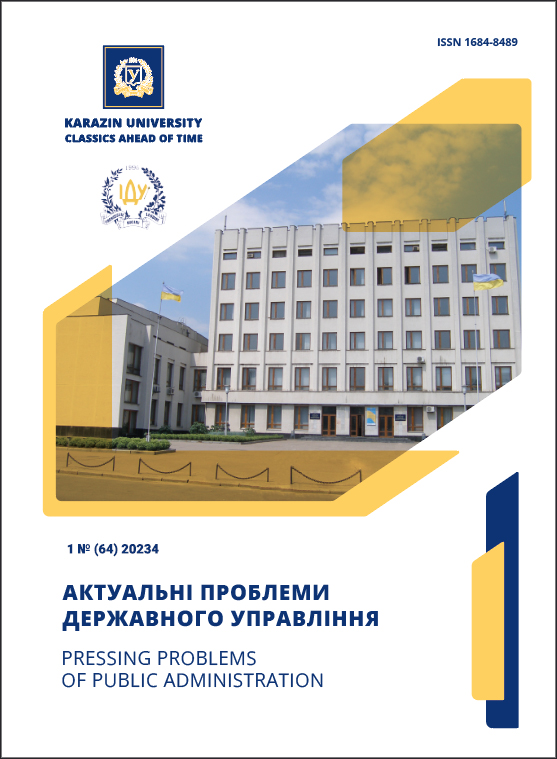An Impact of the Network Governance Doctrine on Legitimacy of Self-Governed Entities
Abstract
The paper is devoted to the substantiation of the modern possibilities of the network approach in public governance and the definition of those aspects of it that provide for the expansion of self-regulating principles of economic activity for the needs of Ukraine. This study explores the influence of the network governance approach on the institutionalization of self-regulatory organizations. It reveals that the network approach, which challenges traditional hierarchical management models and emphasizes collaborative and decentralized structures, significantly shapes the landscape of self-regulatory organizations. These organizations exemplify network management, wherein industry participants voluntarily establish their own rules, fostering a more adaptable regulatory framework. Furthermore, they serve as platforms for information exchange among industry members, promoting collective understanding of best practices, standards, and emerging challenges.
The study demonstrates that the network approach facilitates the formation of expert communities within self-regulatory organizations, enabling the development of regulatory standards based on firsthand industry knowledge. Operating within a network governance model enables these organizations to swiftly adapt to industry changes, technological advancements, and emerging risks compared to traditional bureaucratic regulatory bodies.
Moreover, the network approach underscores the importance of trust and social capital in governance, with self-regulatory organizations relying on trust among members and external stakeholders to uphold their rules. Building and maintaining trust within the network are essential for effective self-regulation. Additionally, the study suggests that regulatory responsibilities can be shared among various actors, and self-regulatory organizations and can complement government regulation by offering detailed and tailored regulatory frameworks that address industry-specific nuances.
The network approach also incorporates peer monitoring and accountability mechanisms, with members of self-regulatory organizations monitoring each other’s adherence to established rules.
Downloads
References
Honcharenko, O. (2020). Theoretical and legal principles of self-regulation of economic activity: A monograph. Research Institute of Private Law and Entrepreneurship named after
F.G. Burchak of the National Academy of Legal Sciences of Ukraine [in Ukrainian].
Yehiozarian, A.H. (2015). Peculiarities of network governance in the field of public policy and administration. Efficiency of Public Administration, 44(1), 118–124 [in Ukrainian].
Yelnykova, Yu.V. (2012). Self-regulatory organizations: Concept, functions, and principles of activity. Problems and Prospects of Development of the Banking System of Ukraine, 36, 163–171 [in Ukrainian].
Ivanchenko, K.O. (2019). Political network as an organizational tool of public policy. Regional Studies, 17, 20–25 [in Ukrainian].
Kotukov, O. (2014). Political and administrative networks as a factor of modernization of public administration. Public Administration and Local Self-Government, 2, 119–128 [in Ukrainian].
Kochyn, V. (2015). Civil law relations of participation of business entities in self-regulatory organizations: A monograph. Research Institute of Private Law and Entrepreneurship named after F.G. Burchak of the National Academy of Legal Sciences of Ukraine [in Ukrainian].
Kuzmenko, I.M. (2020). Graph theory: A textbook. Igor Sikorsky Kyiv Polytechnic Institute [in Ukrainian].
Levchyshyna, O.L. (2018). The legal nature of self-regulatory professional organizations: Concept, features, and types. Scientific Notes of Taurida National V.I. Vernadsky University. Series: Juridical Sciences, 29(68), No. 2, 78–82 [in Ukrainian].
Medvedchuk, O.V. (2018). Regulatory aspects of self-regulation development in Ukraine. Investments: Practice and Experience, 13, 98–102 [in Ukrainian].
Molodtsov, O. (2010). Network paradigm of territorial development: Essence, logic of implementation [Doctoral dissertation, National Academy of Public Administration under the President of Ukraine] [in Ukrainian].
Law of Ukraine No. 3585-IX of February 22, 2024, on Amendments to the Law of Ukraine “On State Regulation of Capital Markets and Organized Commodity Markets” and some other legislative acts of Ukraine on improving state regulation and supervision of capital markets and organized commodity markets [in Ukrainian].
Resolution of the Cabinet of Ministers of Ukraine No. 692 of July 7, 2023, on Approval of the Procedure for Acquiring the Status of a Self-Regulatory Organization in the Field of Energy Efficiency of Buildings and the Model Charter of a Self-Regulatory Organization in the Field of Energy Efficiency of Buildings [in Ukrainian].
Serhieiev, V.S. (2011). Political networks as a form of interaction between the state and civil society (theoretical and methodological analysis) [Doctoral dissertation, Oles Honchar Dnipro National University] [in Ukrainian].
Sytnyk, S.V. (2011). Network structure of public policy and administration. Public Administration: Improvement and Development, 5. DOI: http://nbuv.gov.ua/UJRN/Duur_2011_5_5 [in Ukrainian].
Soloviov, S. (2018). Interrelation of strategic communications and network-centricity in public administration. Actual Problems of Public Administration, 3, 83–87 [in Ukrainian].
Filatova, N. (2016). Self-regulatory organizations as subjects of civil law: A monograph. Yaroslav the Wise National Law University [in Ukrainian].
Borzel, T. (1998). Organizing Babylon – On the Different Conceptions of Policy Networks. Public Administration, 76(2), 253–273 (original in English).
Borzel, T. (1997). What’s So Special about Policy Networks? An Exploration of the Concept and Its Usefulness in Studying European Governance. European Integration online Papers (EIoP), 1(16). http://eiop.or.at/eiop/pdf/1997-016.pdf (original in English)
Joining the dots: The role of brokers in nutrition policy in Australia. (n.d.). https://www.researchgate.net/figure/Network-Analysis-of-the-overall-nutrition-policy-network-in-Australia-Key-NGO_fig1_315836016
Knoke, D., & Kuklinski, J. (1982). Network Analysis. Sage Publications.
Marsh, D., & Smith, M. (2000). Understanding Policy Networks: towards a Dialectical Approach. Political Studies, 48(1), 4–21.
Provan, K., & Kenis, P. (2008). Modes of Network Governance: Structure, Management, and Effectiveness. Journal of Public Administration Research and Theory, 18(4), 229-252.
Wellman, B. (1983). Network Analysis: Some Basic Principles. Sociological Theory, 1, 155–200.
Zavattaro, M.S., & Nickels, A.E. (2024). Unveiling power dynamics: qualitative research as a liberatory tool in public administration, Part 2. Public Integrity. no. 1–4. DOI: https://doi.org/
1080/10999922.2024.2347077
Zhang, Y., Ma, Y., & Liang, C. (2024). Understanding older adults’ continuance intention toward wearable health technologies: an empowerment perspective. Behaviour & Information Technology. DOI: https://doi.org/10.1080/0144929X.2024.2350674

